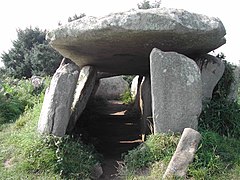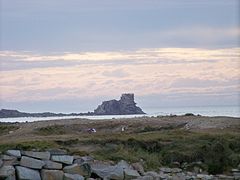Native name: Enez-Veur | |
|---|---|
 Pointe de Toull-ar-Staon, on the north-west of the island | |
| Geography | |
| Location | English Channel |
| Coordinates | 48°48′05″N 3°34′30″W / 48.8013°N 3.575°W |
| Length | 2 km (1.2 mi) |
| Width | 1 km (0.6 mi) |
| Administration | |
| Region | Brittany |
| Department | Côtes-d'Armor |
| Arrondissement | Lannion |
Île-Grande (Enez-Veur in Breton) is an island on the north coast of Brittany (France), linked to the mainland by a road. Its size is about 2 km by 1 km, and there is a village on the island. It is in the commune of Pleumeur-Bodou (department of Côtes-d'Armor).
A smaller island, Île Aganton, is to the west, adjacent to Île-Grande. On the coast, Trébeurden lies to the south-west, and Trégastel to the east.
Prehistory[edit]
In the centre of the island is a prehistoric site, an allée couverte (gallery grave). The site is known as Ty-Lia or Ty-ar-C'horrandoned. Constructed in neolithic times, its size is about 9 metres by 1.5 metres; several upright stones support two large stone slabs.[1][2]
Literary associations[edit]
The writer Joseph Conrad stayed at a house in Île-Grande from 7 April to 14 August 1896, during his honeymoon. He worked there on his novel The Rescue. His short story "The Idiots" was set in the area, and includes many details observed during his stay there; granite-quarrying is mentioned, which was important for the island at that time.[3]
Gallery[edit]
-
Porz Gelen, on the north-east of the island
-
The gallery grave
-
An old quarry
-
St Mark's Church
-
Le Corbeau, seen from the north of the island
References[edit]
- ^ Base Mérimée: Allée couverte, dite Ty-Lia ou Ty-ar-C'Horrandened, Ministère français de la Culture. (in French)
- ^ Ty-Lia The Megalithic Portal, accessed 14 August 2015.
- ^ Joseph Conrad à Lannion et l’Ile grande Terres d'écrivains, accessed 14 August 2015.






Well, that’s interesting to know that Psilotum nudum are known as whisk ferns. Psilotum nudum is the commoner species of the two. While the P. flaccidum is a rare species and is found in the tropical islands. Both the species are usually epiphytic in habit and grow upon tree ferns. These species may also be terrestrial and grow in humus or in the crevices of the rocks.
View the detailed Guide of Psilotum nudum: Detailed Study Of Psilotum Nudum (Whisk Fern), Classification, Anatomy, Reproduction